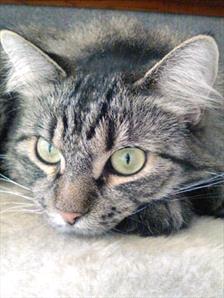
Photo by Laura Hedden
Tritrichomoniasis is a major cause of diarrhea in cats and is caused by Tritrichomonas blagburni. The disease is seen most commonly in young cats and kittens.
T. blagburni is a type of protozoa, which are microscopic, single-celled parasites. They are not related to bacteria or viruses. T. blagburni is transmitted to cats when they come into contact with the organism directly or accidentally eat the infected feces of another cat. Infections are common in crowded environments such as catteries or animal shelters. Thankully, T. blagburni is not contagious to humans or other types of animals, so only cats get it.
Symptoms
Chronic (i.e. long term), voluminous, watery diarrhea is the most common symptom. Diarrhea can come and go so that the cat seems fine sometimes, which can help delay a diagnosis. Cats can also experience excess gas, going more often, foul odor to the stool (we mean more than usual!), and/or trouble defecating.
In general, cats infected with T. blagburni are otherwise normal, have a healthy weight and appetite, and are well hydrated. Sometimes, cats can become dehydrated or develop a poor appetite if the diarrhea is severe or excessive.
What to Expect at a Veterinary Visit
If you suspect your cat has tritrichomoniasis, bring some fresh feces to the veterinary appointment with you. Sandwich-sized plastic zippered bags are great for carrying the diarrhea sample.
Your veterinarian will start with a thorough physical examination, and then check for signs of dehydration and tummy pain. There will likely be an examination of your cat’s feces for intestinal parasites or increased levels of bacteria by looking at the feces under a microscope. Some cats are infected with multiple types of parasites at one time, so it is important that all issues be diagnosed and treated properly.
Unfortunately, T. blagburni is difficult to identify just by looking at the feces. Laboratory tests may be needed and/or blood tests to get an accurate diagnosis. Occasionally, a biopsy may be needed, but this is not common.
Treatment
Medications are available to treat tritrichomoniasis, but they are not always effective. In some cats, especially in those less than one year of age, infections will improve without specific treatment. However, this can take several months.
Supportive care is important to keep your cat healthy during the infection. Feline diets high in fiber can help firm up the stools. Probiotics may also be useful to improve and maintain normal gut/GI flora. Any additional intestinal parasitic diseases need to be treated appropriately as well.
Control and Prevention
Keep your cat’s environment clean and free of feces. Minimize stress where possible by providing plenty of exercise and individual resting spaces. Scoop litterboxes daily and disinfect them regularly. All cats in the household should be tested for tritrichomoniasis because some cats may be infected without showing symptoms. Uninfected cats can be separated from the infected ones to prevent the disease from spreading, although that’s difficult in a home setting.
Call your veterinarian with any questions or concerns, or if new symptoms occur.